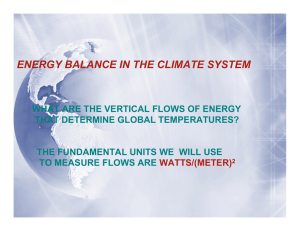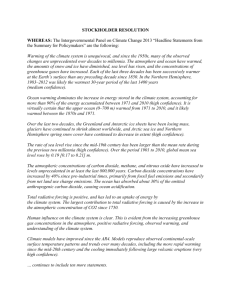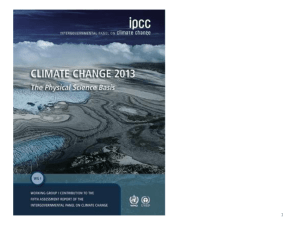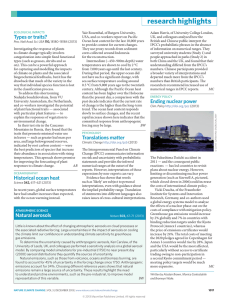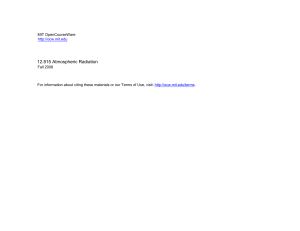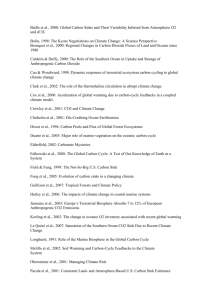Hundreds Gather to Protest Global Warming
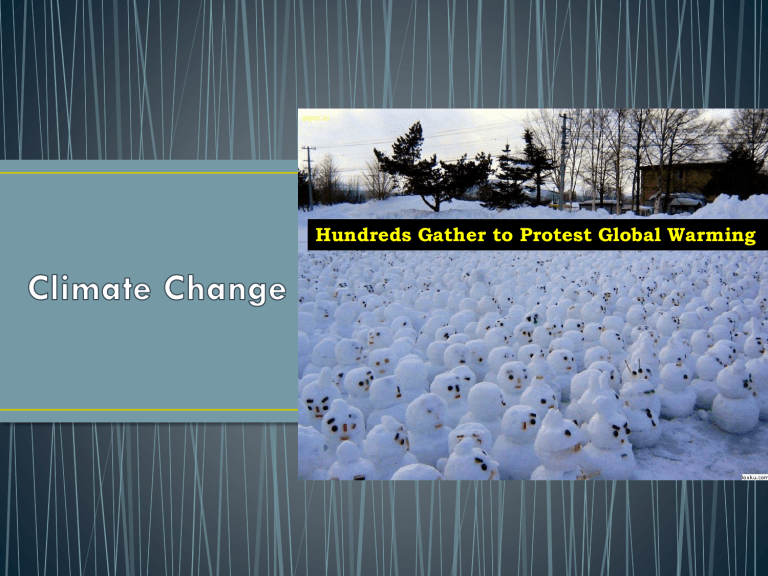
Hundreds Gather to Protest Global Warming
• What is the difference?
• How are they related?
1. Climate Variability:
• Changes over seasons and years ;
• Climate fluctuations yearly above or below a long-term average
• 30 yr average : “climatological normals”
• Example Duluth climate normals 1981-2010
• There is significant variability around these normals
• Example: normal daily max temp for Duluth on
Apr 30 is 56.6 but not every Apr 30 in 1981-
2010 had a max temp of 56.6
This year to year fluctuation around the normal is climate variability
In addition to averages,
ranges
are part of climatological normals.
Example: average annual temperature for
Duluth is
39.7°F
, but there is quite a range of temps around that average
•
Climate variability is caused by (for example) :
•
Volcanic eruptions which can have a cooling effect
•
El Nino-La Nina , cause snowy or non-snowy winters in Duluth
2. Climate Change long-term continuous change to averages or ranges.
long term : many decades
slow, gradual
requires scientific (or other) records
“Climate Forcing”
• Disturbances to global system
• Can be natural or anthropogenic
•
Positive
forcing: induces an
increase
in global mean surface temperature
•
Negative
forcing: induces a
decrease
in global mean surface temperature
1. Plate tectonics
• At geologic time scales
• Changing continent and ocean basin sizes and locations, changing atmospheric composition, changing sizes and locations of mountain ranges
• Change atmospheric and oceanic circulation
• Examples….
Aridity, monsoons, humid regions
Over past few million years, Tibetan Plateau and Himalayas have been rising, causing increased aridity in western China and central
Asia
• Weather vs Climate
• Climate Variability vs Climate Change
• Climate Change caused by Climate Forcings:
• Plate tectonics
2. Astronomical periodicities
• Milankovitch forcings
• “Wiggle”
• “Wobble”
• “Stretch”
• Tilt of Earth’s axis changes
• 21.8° – 24.4°
• Strength of seasons
• 41,000 year periods
• Earth’s axis wobbles
• Changes timing of perihelion and aphelion
• 21,000 yr periods
• Shape of earth’s eccentric orbit changes
• Changes the intensity of solar radiation received at aphelion and perihelion
• 95,000 yrs and 410,000 yrs
Global temperature fluctuations of
± 2 – 5 degrees C per 10,000 yrs
These effects match closely with glacialinterglacial changes over past 100,000 yrs
3. Solar Variability
Sunspot cycle 11 year
± 1 W/m 2 change in solar constant (1372 W/m 2 )
Effects UV radiation
Example: Maunder Minimum 1645-1715 : period of reduced sunspot activity; global temp decrease of 0.5 C
4. Volcanic Eruptions
Big, explosive eruptions can inject dust and sulfur dioxide into stratosphere change into sulfuric acid droplets that reflect solar radiation
Causes global average cooling of tenths of a degree C in year following eruption
Mt Pinatubo 1991 example
5. Human-Induced changes atmospheric composition and land cover changes
1.
Plate tectonics
2.
Astronomical Forcings
3.
Solar Variability
4.
Volcanic Activity
5. Human-Induced Forcings
• Plate tectonics : millions
• Astronomical (Milankovitch) : 10s of 1000s
• These are irrelevant when looking at past 100 years
• Solar, Volcanic, Anthropogenic : relevant to short timescales
• Globally and annually averaged changes in radiation balance at top of atmosphere.
• Plate tectonics and Milankovitch are not radiative forcings
• E.g., Milankovitch decreased obliquity means less summer radiation in
N. hemisphere but is balanced by more S. hemisphere winter radiation.
• These seasonal affects cancel one another
• Solar, volcanic, anthropogenic are radiative forcings
Increased solar radiation :
More solar incoming at top of atmosphere
Increased temperature
Increased greenhouse gas concentration:
More of the longwave emitted from surface is absorbed by atmosphere and less goes out to space.
Net solar incoming exceeds longwave loss:
Increased temperature
CO
2
: positive radiative forcing agent
Sun’s energy : positive radiative forcing agent
Volcanic eruptions : negative radiative forcing agent
• Produced reports in 1990, 1995, 2001, 2007, 2013
• Consensus view of the climate community
• (100s of authors)
IPCC video
• 3 working groups:
• Physical Science Basis
• Impacts, Adaptation and Vulnerability
• Mitigation of Climate Change
(Summary for Policymakers)
• Amount by which a factor alters global and annual average radiation balance at top of atmosphere relative to 1750
(beginning of Industrial Revolution)
In 2011, estimated radiative forcing from anthropogenic
= 2.29 Wm -2 from Fifth IPCC report
• Positive feedbacks: enhance effect; initial increase in temp is reinforced
• Examples:
• 1) water vapor- greenhouse feedback:
• More evaporation, more water vapor (gg), more absorption and radiation of heat
• 2) snow-albedo feedback : warming melting snow and ice cover causes decreased albedo, more absorption, increased temperature
• Negative feedbacks: decrease effect; initial increase is weakened
• Example: warming leads to more cloud cover, increasing albedo, decreasing temperature
• Positive feedbacks dominate
• Quaternary began 2.6 my BP
• Pleistocene Epoch 2.6 my BP – 11, 500 y BP
• Holocene Epoch 11, 500 – present?
• Anthropocene Epoch ???
• 8 cycles (100,000 y each) of glacials/interglacials
• Most recent Ice Age : 3 my BP
• We are in this Ice Age now, in warm part
• Last Glacial Maximum : 25-18,000 y BP
• Ended 15,000 -13,000 y BP
Temps 5-8°C lower; sea level 130 m lower
• This interglacial that we are in should last another
30,000 yrs
• Glacials and interglacials match Milankovitch cycles
• Onset of Mil. forcing led to summer cooling over northern land masses.
• Positive feedback : more snow cover: higher albedo
Mid16th to late 19 th Century
Coldest interval 1570-1730
• Extensive Arctic sea ice and glacial advances
• Mid-19 th Century warming ended the Little Ice Age
• Most pronounced in N hemisphere
• Four periods:
• 1880 – 1920 : no trend; variations within 0.3°C
• 1920 – mid-40s : warming in N. hemisphere 0.4°C
• 1940s – early 70s : slight cooling N hemisphere; S. hemisphere constant
• (within 0.4°C extremes)
• Mid-1970s – present : marked overall warming
• With regional variability
Rank 1 = Warmest
Period of Record:
1880–2015
Year
1
2
3
4
5
6 (tie)*
6 (tie)*
7
8
9 (tie)*
9 (tie)*
10 (tie)
10 (tie)
2015
2014
2010
2005
1998
2013
2003
2002
2006
2009
2007
2004
2012
Over past decade: very strong warming over northern high latitudes
• Use data from Fifth IPCC report (2013)
• Intergovernmental Panel on Climate Change
• Produced reports in 1990, 1995, 2001, 2007, 2013
• Consensus view of the climate community
• (100s of authors)
• How does each factor change the radiation balance at the top of atmosphere in Wm -2 ?
1.
CO
2
Largest single positive radiative forcing agent
Radiative forcing in 2011 compared to 1750:
1.68 Wm -2
(compared to 1750, increase in CO
2 a radiation imbalance of 1.68) by itself would lead to
IPCC
2. Methane (CH
4
) forcing = 0.97 Wm
-2
3. Halocarbons (partially halogenated organic compounds) forcing = 0.18
4. Nitrous oxide forcing = 0.17
Total RF from well-mixed gg = 3 Wm
-2
Carbon monoxide (CO) RF = + 0.23
Non-methane volatile organic compounds (NMVOC) (benzene, ethanol, etc) RF = + 0.10
.
Nitrous oxides (NOx) RF = - 0.15
Total = + 0.18
• Except for black carbon (soot from fossil fuel burning) they are negative forcing agents:
• Net negative RF = - 0.27
• Direct and indirect effects:
• Direct : aerosols absorb and scatter solar and longwave radiation
• Indirect : aerosols act as condensation nuclei for clouds:
• Adds additional negative RF of -0.55
• Great uncertainty IPCC
• Climate Forcings:
• Plate tectonics
• Astronomical Forcing
• Solar Variability
• Volcanic Eruptions
• Human-Induced Forcings radiative
• Quantify radiative forcing by looking at change at top of atmosphere relative to 1750
• In 2011 : +2.29 Wm -2
• Carbon dioxide responsible for 1.68
• Positive and negative radiative feedback
• Quaternary Period began 2.6 myBP
• Includes Pleistocene and Holocene Epochs
• 8 pulses of glacials and interglacials
• We have been in an interglacial since 15,000-13,000 years ago
• Top 10 warmest years since 1880 in 2000s except 1998
• Greatest warming has been in high latitudes of Northern
Hemisphere
• Aerosols: greatest uncertainty in climate change science
• Mostly negative effect except for black soot
• Lifetime in atmosphere: 12 years
• propellants in aerosols, as blowing agents in foam manufacture, in air conditioning units and refrigerants
Lifetime in atmosphere:
HFCs: 1-270 years
PFCs: 2,600-50,000 years
NF3: 740 years
SF6: 3,200 years
• Lifetime in atmosphere : 114 years
• Sources: 90% are natural (not anthropogenic)
Dust storms, vegetation, forest fires, volcanoes, sea salt
• Fossil fuel combustion, burning vegetation, incinerators, smelters, power plants
• Direct : aerosols reflect solar radiation back to space
BUT depends on color, size composition
Some aerosols (soot) are dark and absorb solar radiation
Sea salt, dust, volcanic ash
Indirect: aerosols are necessary for cloud formation
Aerosols from pollution create small cloud droplets and reflect more solar radiation than natural aerosols
• Overgrazing and forest clearance : increase albedo
• Deforestation and biomass burning increase CO
2
• Net negative RF = -0.15
• Positive forcings are countered by negative forcings
• especially due to aerosols.
• Lowering total net anthropogenic forcing to + 2.29 Wm -2
• Uncertainty is due to uncertainty in aerosol effects
• The total anthropogenic RF for 2011 relative to 1750 is 2.29
[1.13 to 3.33] W m − 2
• has increased more rapidly since 1970 than during prior decades.
• 43% higher than that reported in IPCC 4 th Report for the year
2005.
• caused by a combination of continued growth in most greenhouse gases
• concentrations and improved estimates of RF by aerosols indicating a weaker net cooling effect
• Page
• Black lines: observations
• Wide blue lines: climate models using only natural forcings
• Wide pink lines: climate models using natural and anthropogenic forcings
• Show: ARCTIC AND ANTARCTIC SEA ICE EXTENT
• UPPER OCEAN HEAT CONTENT (OHC) IN MAJOR OCEAN
BASINS
• CONTINENTAL LAND SURFACE TEMPERATURES
• General Circulation Models
• Atmospheric Ocean GCMs (AOGCMs)
• Modeling groups worldwide have developed GCMs
• IPCC assesses impacts of projected increases in gg and consequences for 21 st Century
podcast
• New models use range of gg emission scenarios
( RCPs : Representative
Concentration Pathways)
• GG concentration trajectories; represent a range of climate outcomes
• RCPs used in Fifth report
(2013):
• “Each RCP could result from different combinations of economic, technological, demographic, policy, and institutional futures. For example, the second-to-lowest RCP could be considered as a moderate mitigation scenario. However, it is also consistent with a baseline scenario that assumes a global development that focuses on technological improvements and a shift to service industries but does not aim to reduce greenhouse gas emissions as a goal in itself”.
RCP2.6
RCP4.5
RCP6.0
RCP8.5
2100 RF relative to
1750
2.6
4.5
6.0
8.5
Mitigation scenario
21 st Century climate policies
Very low forcing level
RF peaks and declines stabilization RF stabilizes by 2100 stabilization RF doesn’t peak by 2100
Very high GG forcing
RF doesn’t peak by 2100
• Temperature
• Water Cycle
• Ocean
• Cryosphere
• Sea Level
• Carbon Cycle
• Climate Change Stabilization,
Commitment and Irreversibility
1.
Global surface temperature change for the end of the 21st century is likely to exceed 1.5°C relative to 1850 to 1900
2.
Warming will continue beyond 2100
3.
Warming will continue to exhibit interannual-to-decadal variability and will not be regionally uniform
4. The global mean surface temperature change for the period
2016–2035 relative to 1986–2005 will likely be in the range of 0.3°C to 0.7°C larger in the tropics and subtropics
19 year periods
5. Increase of global mean surface temperatures for 2081–2100
(late 21 st Century) relative to 1986–2005 is projected to likely be
0.3°C to 1.7°C
1.1°C to 2.6°C
1.4°C to 3.1°C
2.6°C to 4.8°C
Different RCPs
6. Arctic region will warm more rapidly than the global mean
7.
warming over land will be larger than over the ocean
8. virtually certain that there will be more frequent hot and fewer cold temperature extremes over most land areas
9. very likely that heat waves will occur with a higher frequency and duration. Occasional cold winter extremes will continue to occur IPCC
• “Changes in the global water cycle in response to the warming over the 21st century will not be uniform . The contrast in precipitation between wet and dry regions and between wet and dry seasons will increase , although there may be regional exceptions”
1. high latitudes and the equatorial Pacific Ocean are likely to experience an increase in annual mean precipitation by the end of 21 st century
2. mid-latitude and subtropical dry regions, mean ppt will likely decrease
3 . mid-latitude wet regions , mean ppt will likely increase
4. Extreme precipitation events over most of the mid-latitude land masses and wet tropical regions will very likely become more intense and more frequent
5. likely that the area encompassed by monsoon systems will increase over the 21st century.
(While monsoon winds are likely to weaken, monsoon precipitation is likely to intensify )
6. high confidence that the El Niño-Southern Oscillation (ENSO) will remain the dominant mode of interannual variability in the tropical Pacific
IPCC
• “global ocean will continue to warm during the 21st century.
Heat will penetrate from the surface to the deep ocean and affect ocean circulation ”.
1.
strongest ocean warming is projected for the surface in tropical and Northern Hemisphere subtropical regions. warming in the top 100 meters: 0.6°C to 2.0°C
2.
At greater depth the warming will be most pronounced in the
Southern Ocean.
1000 m 0.3°C to 0.6°C
over the 21st century. some decline in the
AMOC by about 2050
(It is very unlikely that the
AMOC will undergo collapse in the 21st century. However, a collapse beyond the 21st century for large sustained warming cannot be excluded)
• “very likely that the Arctic sea ice cover will continue to shrink and thin and that Northern Hemisphere spring snow cover will decrease during the 21st century as global mean surface temperature rises. Global glacier volume will further decrease”.
1.
Year-round reductions in Arctic sea ice extent are projected by the end of the 21st century
43% to 94% in September and from 8% to 34% in February
2. a nearly ice-free Arctic Ocean in September before midcentury is likely (in one RCP)
3. In Antarctic , a decrease in sea ice extent and volume is projected with low confidence for the end of the 21st century
4. end of the 21st century: global glacier volume (excluding periphery of Antarctica) decrease by
15 to 55%
35 to 85%
5. Northern Hemisphere spring snow cover is projected to decrease by 7% - 25%
6. permafrost (upper 3.5 m) extent at high northern latitudes will be reduced is projected to decrease by between 37% to 81%
“Global mean sea level will continue to rise during the 21st century.
Under all RCP scenarios, the rate of sea level rise will very likely exceed that observed during 1971 to 2010 due to increased ocean warming and increased loss of mass from glaciers and ice sheets”
1. Global mean sea level rise for 2081–2100 relative to
1986–2005 will likely be in the ranges of
0.26 to 0.55 m
0.32 to 0.63 m
0.33 to 0.63 m
0.45 to 0.82 m
2. thermal expansion accounts for 30 to 55% of 21st century global mean sea level rise, and glaciers for 15 to 35%.
( The increase in surface melting of the Greenland ice sheet will exceed the increase in snowfall, leading to a positive contribution to future sea level )
(increase in snowfall on the Antarctic ice sheet is expected resulting in a negative contribution to future sea level )
Changes from both ice sheets combined :
0.03 to 0.20 m by 2081 − 2100
IPCC
3. Sea level rise will not be uniform .
By the end of the 21st century, it is very likely that sea level will rise in more than about 95% of the ocean area.
70% of the coastlines worldwide are projected to experience sea level change
“Climate change will affect carbon cycle processes in a way that will exacerbate the increase of CO2 in the atmosphere .
Further uptake of carbon by the ocean will increase ocean acidification”
1.
feedback between climate and the carbon cycle is positive in the 21st century climate change will partially offset increases in land and ocean carbon sinks caused by rising atmospheric CO2. More of the emitted anthropogenic CO2 will remain in the atmosphere.
2. global increase in ocean acidification for all RCP scenarios. decrease in surface ocean pH by end of 21st century :
• 0.06 to 0.07
• 0.14 to 0.15
• 0.20 to 0.21
• 0.30 to 0.32
IPCC
3. By 2050 , annual CO2 emissions (derived from Earth System
Models): smaller than 1990 emissions (by 14 to 96%).
By the end of 21st century, about half of the models infer emissions slightly above zero, while the other half infer a net removal of CO2 from the atmosphere.
“Most aspects of climate change will persist for many centuries even if emissions of CO2 are stopped. This represents a substantial multi-century climate change commitment created by past, present and future emissions of
CO2 “
1. Cumulative total emissions of CO2 and global mean surface temperature response are linearly related.
Limiting the warming caused by anthropogenic CO2 emissions alone to less than
2°C (since 1861–1880) will require cumulative CO2 emissions from all anthropogenic sources to stay between
0 and 1570 GtC
0 and 1210 GtC
0 and 1000 GtC since that period
515 was already emitted by 2011
2.
large fraction of anthropogenic climate change resulting from
CO2 emissions is irreversible on a multi-century to millennial time scale
Surface temperatures will remain approximately constant at elevated levels for many centuries after a complete cessation of net anthropogenic CO2 emissions .
Due to the long time scales of heat transfer from the ocean surface to depth, ocean warming will continue for centuries .
15 to 40% of emitted CO2 will remain in the atmosphere longer than 1,000 years.
IPCC
